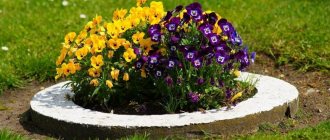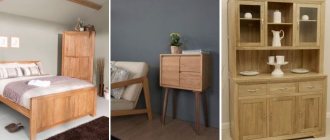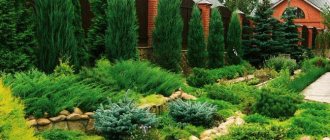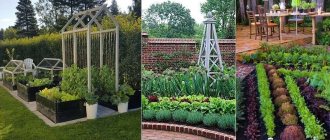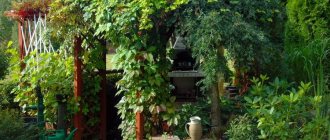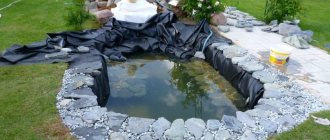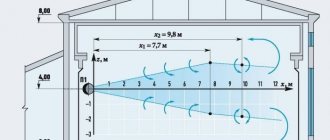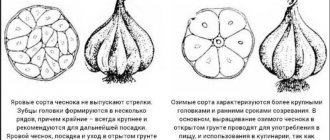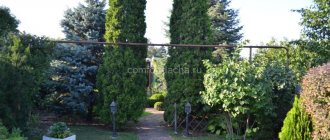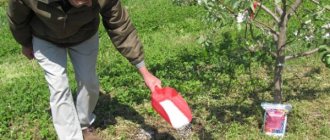Coniferous plants are often indispensable for landscape design. An easy-to-maintain green garden decoration will look great all year round and purify the air. Compositions from coniferous plants are easy to combine with other elements; you can add shrubs, stones and even flowers.
Despite the fact that in nature we have only a few species of conifers, due to introduced species, and even more due to the selection of ornamental varieties, the market offers a choice of hundreds of plants that are resistant to our climate. Therefore, everyone, if desired, can create a corner of harmony on their site to their own taste.
Secrets of creating perfect compositions
Conifers in the landscape design of small areas are often chosen among dwarf varieties. Small plants are compact and do not clutter up the area, but they grow more slowly and therefore may command higher prices. Before buying plants, it is better to draw up a sketch in advance or order a project from us, calculate the required number of plants of each variety, taking into account the available area and the size of adult plants, prepare places for planting, and only then go to the garden center or nursery.
During landscape design, do not forget about the spatial composition; try to make sure that all the elements of coniferous and deciduous plants are combined in size and shape, and do not contradict the surrounding space. It is always easier, cheaper and better to follow existing natural conditions than to try to radically change them. If the neighboring forest grows mainly pine trees, then on your site, most likely, there will also be suitable conditions for them.
Not the last place when drawing up a plan should be occupied by the color scheme - many conifers used in landscape design differ significantly in tone. The palette is varied - there are plants of pale light green, rich green, yellow, blue and other colors. At the same time, the color of the plant changes with the season. Young growths usually look the brightest. If you are thinking over a composition that will include three elements, use no more than two colors. The maximum for a composition of five elements is three colors. In the case of large-scale projects using different breeds over large areas, it is better to separate groups by color to avoid disharmonious combinations.
Harmonious color combination
Much depends on your goals. If the task is simply to decorate the area and try your hand at a new business, then it is better to start with a small project - for example, a flower bed or an alpine slide. Many gardeners choose coniferous trees to create a hedge to separate the area from the neighboring area, extraneous sounds and dust. This way you can zone the space - for example, fence off a utility area or create a garden room. To replace the classic yew hedge, they use common spruce - a very popular option in Scandinavia and Finland, less often other types of spruce - Serbian, prickly. Western thuja hedges are very popular. It grows quickly and lends itself well to molding. Less commonly, hedges are grown from pine trees or junipers.
Coniferous hedge. Serbian spruce, then larch. In the foreground is the mountain pine “Pumilio”.
Creating a landscape design from coniferous plants with your own hands is a difficult but exciting task for beginners. Therefore, if you decide to try, then first study as much material as possible on this topic. Pay attention to one common mistake when conifers are called conifers. Conifers can probably be used in landscape design; but we would not recommend doing this, since growing conifers may fall under an article of the criminal code. Ephedra is a foliage narcotic plant. Don't confuse it with spruce ;)
Conifers for the garden
Almost all coniferous plants are suitable for creating artificial landscapes. But which species are suitable for designing a particular territory depends on the area of the site, the degree of its shading, terrain features and soil type. The design of the garden should also be taken into account when selecting vegetation, but it should be noted that conifers look natural in any landscape style.
Pine
From the pine family, all types of spruce, pine and fir are used in ornamental gardening. From natural conditions, medium-sized, and less often tall, trees have moved into gardens and are successfully cultivated, and dwarf coniferous plants have been bred through selection.
Pines and spruces thrive on sandy and rocky soils, but on loams and black soils they require high-quality soil drainage, since they do not tolerate stagnant moisture.
It’s not for nothing that they are used to create an alpine slide
Fir is one of the most beautiful coniferous species. It has a property not inherent in other coniferous plants - it reproduces by layering. Having dug up the young shoots, they can be replanted and in a few years you will get a full-fledged plant. Fir grows well on sandy and rocky soil, loam and black soil.
Korean fir diamond
Larch also has its own “zest” - unlike its coniferous relatives, it sheds its needles for the winter, just as deciduous trees shed their leaves. In autumn, before shedding, larch needles change color from green to various shades of yellow. Like all pine trees, the plant is unpretentious and not capricious.
Cypress
The main representative of the cypress family, the cypress is a tall tree with a narrow pyramidal crown. The plant is not frost-resistant, so it is grown in regions with mild winters. In addition, cypress is sensitive to gas pollution in city streets and does not tolerate crowded plantings, which also limits its scope. Where climatic conditions allow the use of cypress, it is included in the mountain landscape with multi-level buildings, group plantings are created and framed alleys.
Large-fruited cypress Goldcrest
The most striking and frequently used representative of cypress trees in decorative landscaping is juniper. The genus includes low-growing and large trees, reaching a height of 15 m, as well as shrubs of various shapes and habit.
Thujas are coniferous evergreen trees; most species are frost-resistant and can easily tolerate pruning. They are equally easy to propagate by seed and cuttings. The variety of species and varieties makes it possible to use thuja in almost any type of planting: groups, tapeworms, hedges, creating a background, alleys and even borders.
Alpine slide
The Alpine slide is created according to the same principle - creating an imitation of the wild nature of the Alpine belt. Keeping the previous principle in mind, you can combine coniferous compositions in landscape design with other plants and stones. It is important not to fall into typical mistakes described in English literature of the 19th century, and not inadvertently make a “dog’s grave” or “raisin bun”.
Miniature alpine slide - rock garden in a stone trough (miniature rolling pin)
Try choosing a cascading structure to add a special charm to the area. It is important to arrange the parts so that large elements do not block smaller ones.
Purchasing plants
Coniferous trees for creating compositions can be purchased both in special nurseries and in garden stores .
Recent Entries
Chainsaw or electric saw - what to choose for the garden? 4 mistakes when growing tomatoes in pots that almost all housewives make Secrets of growing seedlings from the Japanese, who are very sensitive to the soil
It is not worth digging in natural forests and groves, because, firstly, it may be illegal (if this territory belongs to some biosphere reserve), and secondly, it is unpredictable what the adult plant will be like, even within the same species, wild specimens may vary greatly (this depends on many factors and heredity), thirdly, there is the possibility of introducing new types of pests into your garden.
There is no need to buy a plant just because it is beautiful and cute. It is recommended that you study the Latin name , first inquire about the size and habit of an adult plant, and buy only those plants that are suitable for a particular site.
Conifers, especially young ones, are strikingly similar and only a specialist can distinguish them externally. This is a rather expensive purchase, designed to last more than one year, so you should prepare for it in advance, arm yourself with a catalog with descriptions and photographs. Very often we see the disappointment of buyers of extremely expensive topiary forms grown in Western nurseries (formed by special pruning of seedlings) when they are created from species that are not zoned in our latitudes.
We should not forget that it is advisable to buy coniferous plants with a clod of soil; dendrological nurseries sell them in burlap or wire mesh; the best option is grown in a container; they can be planted in any season . Naturally, you need to buy seedlings only in reputable garden centers, after checking the general condition of the needles and the quality of the root system. Quite a few novice gardeners have “burnt themselves” by purchasing cheap cuprossociaparis and cypresses in pots, often sold in supermarkets; they often sit there, without watering, for weeks. After such conditions, these delicate plants recover extremely difficultly, most often dying during the first wintering.
As for the price of seedlings, coniferous ones most often cost more than deciduous ones, container ones are more expensive than those grown in the ground, grafted and topiary ones are more expensive than those grown without shaping, etc. Designers most often recommend purchasing several accent, central plants ( about 1.0-1.5 m in height ) to give the flowerbed volume, and buying the rest small (no more than 40 cm). But at the same time, you need to be prepared for the fact that dwarf species grow extremely slowly (sometimes less than one cm per year) and having planted them very small, you will need to expect the required decorative effect from them for many years.
Selection of plants for a coniferous composition
When you see a coniferous garden in a photo, it seems that creating your own composition will not be difficult, but the first problems arise almost immediately - when choosing plants.
Choosing conifers is not an easy task
In a small garden, you should not use seedlings of wild spruce and pine trees - it will be difficult to keep them compact, and they will quickly reach their characteristic height and diameter, taking up almost the entire space on the site.
Choose compact plants that have been specifically bred for landscape design, because their growth is not as active and will not negatively affect the composition in the future. This will require special literature and catalogs published by large nurseries or industry associations. The most complete catalog in Russia is published by the Association of Planting Material Producers of Russia, APPM.
Choosing the right plants is the key to success
All conifers can be divided into three groups depending on size:
- Tall growing . This group includes prickly spruce, which can reach 40 meters in height, Serbian spruce with a narrow crown, prickly spruce, including the blue form, Scots pine, Siberian pine (cedar), and pseudohemlock.
- Medium growing . Western thuja and its varieties “Brabant”, “Smaragd” and others, Scots pine “Norske Type”, mountain pine, columnar juniper, some varieties of prickly spruce.
- Undersized . An array of mountain pine “Pumilio”, common spruce “Nidiformis” (nest-shaped form), common juniper “Repanda” (creeping form pressed to the ground), horizontal juniper, microbiota (“Russian cypress” native to the Far East) can look impressive on the site. .
Types and varieties of decorative coniferous trees for landscape design
Growing conifers from seed is a long and complex process, so seedlings are most often purchased to decorate suburban areas. Please note that thorny trees may interfere with passage. Many conifers grow slowly. If you don’t want to wait a long time, you can choose fast-growing breeds.
Chaotically planted trees Source www.websad.ru
Fast growing
There are many representatives of coniferous flora in this category. With their help, in a short time the landscape takes on a complete, beautiful look. Already in the first years, seedlings actively increase their green mass. During this period, the crown is trimmed to give the desired shape. Fast-growing conifers take root well in a new place, with virtually no losses. But varieties should be selected based on their suitability to specific climatic conditions.
Thuja occidentalis
To create a green hedge, you can use thuja occidentalis. It is a fast-growing evergreen species and tolerates winter well. In the 3rd or 4th year, a full-fledged living fence will be formed.
Subtleties of planting and care
Before planting a tree or shrub, consider that it will need more space in the future, so leave room to spare based on the size of the mature plant. If the diameter of an adult shrub is, for example, three meters, then this is the minimum area that must be allocated for this variety . Several smaller seedlings can be planted in this area, which will quickly close their crowns and cover the ground.
It is important to leave enough space for conifers to grow. The planting density and size of the clumps is determined both by the dimensions of adult plants and the size of seedlings.
Most species require minimal care - systematic watering in the initial period and during drought, weeding, the soil must be loosened and fertilized in a timely manner. You can pinch young shoots to form a crown.
Follow simple but important rules:
- Under no circumstances should the root collar be allowed to go deep. It is necessary to check whether it is buried during the packaging of the plant in the nursery. You need to find the main, skeletal thick roots. The top of the roots extending from the trunk, like the spokes of a wheel, should be located at the level of the top of the soil.
- Mulch the plantings with crushed bark, wood chips or pine needles 4–5 cm thick, without covering the root collar.
- When you combine tall and short plants, achieving harmony can be difficult. To avoid a feeling of clutter, do not choose plants of many types and colors. It is better to use one or two species, or varieties, but in large quantities, than to plant the entire range of the garden center on the site.
- Try playing with geometry by combining different shapes - for example, spherical and pyramidal plants.
The ideal time for planting is spring after the soil has thawed or from late summer to early autumn. In mid-summer you can plant conifers on the site, but it is better to avoid hot periods. It is better to mark planting sites in advance using pebbles or pegs. In this case, it is important to prepare the planting holes and soil - mix the soil with peat and sand. The recipe for the soil mixture depends on the available soil; you can dilute it with sand and peat.
Most conifers prefer well-drained soils, so in areas with heavy, clayey soils you will have to make large planting holes with lighter soil and lay drainage for the bases of the planting holes and pit, leading it into a drainage system or ditch.
Look at the trees growing naturally on and near your property. If these are pine trees, then the soils are most often sandy and light; Spruce trees tolerate dry soil less well.
Newly planted dwarf cedar (Pine pine) and Scots pine (in the background).
When planting a plant with a clod of soil in burlap and netting, after placing the seedling in place in the hole, cut the top of the netting and untie the burlap, find the main roots and make sure that the root collar is not buried. After this, remove the mesh from the top of the ball, fill it with soil around the ball, and spill it with water. Add soil again and compact it with your foot.
When planting a plant from a container, also make sure that the root collar is not buried and that the roots are not curled. If necessary, remove the soil to the level of the root collar, and all small roots that may have grown around the trunk above the main roots. Roots tightly twisted along the walls of the container are a defect; it is better not to take such plants; but cut the top layer with a sharp knife in four to five places, vertically.
After planting, it is better to mulch the tree trunk or the entire clump (chopped bark, wood chips, cones or pine needles are used as mulch, depending on what is available and what is convenient to use). Mulch helps retain moisture, maintain soil life, and discourage weed growth. The thickness of the mulch should be sufficient, at least four centimeters. After planting, water the plants regularly, especially in hot weather. However, you should not overwater them, especially in heavy soil. Roots, first of all, require oxygen, and they should not be allowed to soak for long periods of time. The plant may die.
There is an excellent signal that will help you understand that thujas, ornamental spruces and junipers feel great in a new area - this is the appearance of new growths. Coniferous plants grow actively in central Russia and the North-West in late spring - early summer, then the growth of shoots stops. The second wave of growth, much weaker, occurs in August. Plants need to be planted so that they do not interfere with each other.
How to create a coniferous mixborder
To get the desired effect when arranging a site, you can use a ready-made mixborder scheme, or you can design it at your own discretion. This can be done either on paper or using a computer program. For convenience, you need to make a marking according to the types of plants used, assigning each crop its own color. It is also recommended to take into account the location of decorative stones and other design elements. And don’t forget about garden paths, areas for going deep into the English mixborder.
When planting plants, you should not allow them to become too dense, otherwise it will have a depressing effect on them. Each crop should have enough free space in the mixborder; empty spaces at the growth stage can be filled by planting annual or potted flowers. In the future, permanent plantings are planted instead.
For large-sized specimens, it is quite normal to allocate at least one meter of area, and for medium-sized forms - from 60 cm. If crops with a low degree of resistance to frost are used, then for ease of shelter it is recommended to place them close to each other. When creating a combined flower garden - coniferous mixborder, it is allowed to plant identical plants at certain distances.
Soil preparation
Mixborders should be planted after warm weather sets in, when the threat of return spring frosts has passed. It is quite acceptable to carry out planting work in the autumn, the main thing is to do it a month before the onset of cold weather. Otherwise, the plantings will not be able to take root and will die.
The process of preparing areas for mixborders is carried out according to the standard scheme:
- the area is cleared of weeds;
- dig deep (on the bayonet of a shovel);
- saturate with useful elements (mineral complex, rotted organic matter);
- if necessary, dilute with sand (if the soil is heavy);
- deoxidized with lime or dolomite flour.
To create the most comfortable conditions for the growth and development of mountain and rocky plants, you need to use gravel or expanded clay followed by digging up the soil. It is quite normal for meadow perennials to grow in normal garden soils. At the end of the preparatory work, markings are made in the area allocated for the mixborder according to the plan.
Planting
Large plants with a height of 80-150 cm are planted first, which will form the “skeleton” of a complex flowerbed, setting its height and background. From conifers choose:
- Konica spruce;
- Tuyu Dannika;
- cypress;
- mountain pine Winter Gold;
- juniper scaly.
Among flowering shrubs, the following varieties are excellent for mixborders:
- magnolia;
- hydrangea;
- jasmine;
- hibiscus.
In addition, plants such as:
- Przhevalsky's buzulnik;
- elecampane tall;
- delphinium;
- artichoke;
- multi-grid;
- pampas grass.
In the middle of the mixborder, it is effective to plant vines and tall plants (50-80 cm), which will cover the trunks of trees and shrubs. Works great with this function:
- Rudbeckia is beautiful;
- rudbeckia Golden ball;
- decorative bow;
- Phlox paniculata;
- peonies;
- lily;
- aconite;
- lupine.
You can also dilute the flower garden by planting wormwood pursha, astilbe Thunberg, Chilean gravilate, and milkweed multiflorum. Mixborders made from conifers and roses look original. Thanks to this approach, it is possible to create unique combined flower beds with an English accent.
To cover the bases of planted plants, low-growing crops with bright flowers or original leaf mass should be placed in the foreground. It is especially good to use Korean chrysanthemum, bergenia, daffodils, primrose, tulips, as well as gypsophila and lungwort for these purposes. Among groundcovers, the following are especially valued:
- phlox (subulate, splayed);
- splint;
- Stachys woolly;
- Duchesnea;
- creeping thyme.
If you need shade-tolerant plants, then it is better to give preference to creeping tenacious, hoofed grass, and periwinkle. Of the long-flowering varieties, it is worth choosing purslane or sedum. Barberries, which are distinguished by their hardiness and ability to grow both in sunny areas of the garden and in partial shade, are also suitable for decorating a coniferous mixborder. Upon completion of planting the main components of the mixborder, annual plants such as night violets, asters, marigolds, nasturtiums, and petunias are sown. The contour of the flower bed is decorated with gravel, decorative stone or sand.
Pine
Gardeners often choose pine trees for their unpretentiousness to climate and soil.
Pine seedlings
Pine seedlings in the nursery
Pines in the landscape design of the fourth and fifth climatic zones, which corresponds to the most populated territory of the middle zone and north-west, are used as follows: Scots pine, Scots pine “Norske Type”;
Surprising as it may seem, some varieties of very winter-hardy Scots pine growing in the Arctic Circle are not winter-hardy enough in St. Petersburg, including the “Votereri” variety.
- Mountain pine and its many forms and varieties (Pumilio, Mugus, Winter Gold, Pug and others);
- Rumelian pine (Balkan) with very long needles and large cones;
- European and Siberian pine;
- Korean pine, with very large edible nuts;
- dwarf pine (dwarf pine), reminiscent of mountain pine, but with edible pine nuts and bluer needles.
- The once popular Weymouth pines are highly susceptible to attack by rust fungi and are almost out of use.
Pine bonsai against the background of a coniferous hedge
Which neighbors to choose for conifers
It is best to choose plants that are well compatible with conifers by taking a closer look at wildlife. First of all, cereal plants coexist well with gymnosperms. By the way, here you can break the stereotype by planting a dwarf spruce or pine next to a tall perennial. Sandy grate, miscanthus or anafalis get along well with mountain pine. And fescue looks harmonious next to tiny young seedlings. The ideal neighbor for conifers is heather. These plants prefer the same type of soil. Therefore, in nature, pines and heathers are often located nearby. If we are talking about a mixed flower garden, you can choose suitable summer gardens. For example, medium-height lavatera and squat mountain pine form a charming composition. The low Christmas tree Glauca Globosa looks lovely surrounded by cineraria, hydrangea or begonia.
Now consider more specific examples of compatibility for the most popular conifers: fir, spruce, larch and pine:
- Pine. It gets along well next to linden, oak, cedar, rowan, Tatarian maple or larch. Negative neighborhood - aspen or birch;
- Fir. The most desirable option is “solo” planting, since this tree suppresses the development and growth of other crops;
- Spruce. Goes well with hazel, rowan or raspberry. Does not get along well with rose, viburnum, rose hips, barberry, lilac, horse chestnut, white acacia and thuja;
- Larch is a “jealous tree” that does not tolerate the presence of other varieties of conifers throughout the area.
We must not forget that sometimes conifers have an adverse effect on other plants. For example, rose flowers look great against the backdrop of lush green pine needles. But such a neighborhood is undesirable specifically for rose bushes, since the needles oxidize the soil.
Spruce
This tree, typical of the middle zone, also does not require serious care. In landscape design, common spruce, Serbian spruce, and prickly spruce, which has a green and blue shape, and many decorative varieties are used. For large compositions, tall trees are used.
The blue spruce on the site is not necessarily the blue form of the prickly spruce. In Serbian spruce, due to the color of the underside of the needles, the overall color is also slightly blue.
Spruce on the site. Simple topiary made from Norway spruce
Other spruces are also used:
- Dwarf variety of Serbian spruce “Nana”;
- A spherical variety of prickly spruce with blue needles “Glauca globoza”;
- A narrow-clone variety of common spruce with weeping branches “Inverse”.
Common placement options for weeping conifer species
The most common use of coniferous trees is to arrange them among stone boulders when creating a rock garden. For this you will need:
- Select low varieties of conifers and plant them.
- Dig several containers with holes in the bottom near each plant for watering.
- Constantly weed.
- Place blocks of stone and boulders near the planting.
Various varieties of weeping trees, differing in the color of their needles, also look good.
They are usually planted in small groups. Silver, blue and white-variegated conifers look picturesque against the background of plants with dark needles. If the needles of a tree are yellow, you should not place them near green specimens! Otherwise the yellow tree will look sick.
So, coniferous plants with a weeping crown are rapidly entering gardens as specimens for landscape design. There are plenty of tree varieties, so every gardener will be able to design the plot at his own discretion.
Thuja occidentalis
These trees, originally from the west coast of the United States, have long been naturalized in Europe, easily adapt to different conditions, and are not afraid of frost and city air. Easy care and a wide variety of crown shapes make them desirable guests in summer cottages.
Thuja occidentalis on the site
Plants easily fit into different compositions. Thuja makes dense hedges.
Yew hedge. Sissinghurst, UK
Hedges are great for defining green rooms in an area. This hedge of thuja occidentalis 'Brabant' separates the economic area with a vegetable garden from the residential part of the site
How to compose compositions
There is no consensus on this matter. Some designers are proponents of natural landscapes that resemble nature as much as possible. Others enjoy the creative process by experimenting with crown shapes. Everyone is right in their own way. Representatives of both directions have interesting solutions. Let's try to find a compromise option.
It is ideal if the conifer looks as if it grew in nature. At the same time, he must be trimmed and well-groomed. Restraint and a sense of proportion are constant components of good taste. But you shouldn’t be too careful. It is hardly possible to disfigure a piece of land with a living plant.
There are no strict canons or rules in the design of a summer cottage. For example, two separate coniferous trees can create the impression of restlessness. However, the same two Christmas trees planted at the gate will be more than appropriate. Naturally, provided that they are well looked after. When planting crops, we must not forget that from the north side the plant looks worse than from the south, since the needles are shorter and sparse. To ensure that the result does not disappoint, it requires not only good taste and professionalism of the designer, but also the patience of the owner. Many dwarf breeds grow quite slowly. Sometimes people approach the issue simply. Without any extra fuss, they plant the plant they like and take care of it with pleasure, receiving a charge of positivity and good mood.
Juniper
A wide selection of junipers - although there are only a few species suitable for climate zones 4 and 5, they have developed varieties of different sizes and shapes, ranging from trees up to ten meters high, to creeping shrubs with a diameter of several meters, but a height of centimeters.
Juniper. Botanical Garden in Brno
Juniper has gray cones that are used to make gin.
Bonfire
Weeping spruce Bonfire has downward branches. Height – 10 meters. The needles have a bluish-green color. Crown diameter – up to 5 meters. Young shoots are orange-brown in color. The crown is brown, the trunk is curved.
Yew
The yew is the only native conifer in the UK and is associated with perfectly trimmed hedges and free-standing dark conifers. Unfortunately, winter-hardy yew species are very difficult to find, and most yews from Europe do not winter well in our country .
Yew berry, hedge at Sissinghurst
Caring for coniferous mixborders
Despite the unpretentiousness of the plants used to create a flower garden, in order to maintain their decorative properties, they need to be provided with appropriate care. At the stage of active growing season, weeding should be done, clearing the flower garden of problematic vegetation. You can also do this manually, pulling out the weeds by the roots. The use of herbicides in this case is not advisable.
Feeding procedures are carried out 2-4 weeks after planting. Nutrient formulations with high nitrogen concentrations or complex preparations should be diluted with water according to the manufacturer's instructions. To avoid undesirable consequences, you should pour the working solution as carefully as possible, avoiding it getting on the leaf blades of ornamental plants. Otherwise, there is a risk of burns on them. Such fertilizing is relevant for spring, and in autumn it is effective to apply fertilizers with a predominance of potassium and phosphorus.
Important! You cannot overdo it with nutritional compositions, otherwise a favorable environment will be created for the development of fungal infections and the invasion of parasitic individuals.
For better survival at the initial stage of development of the mixborder, irrigation measures should be carried out regularly. They are carried out as the top layer of soil dries. In the future, when the flowerbed grows, watering is done abundantly, but infrequently. The optimal time for carrying out these procedures is morning and evening hours, using a hose with a sprayer or a watering can. After each irrigation, it is advisable to loosen the soil in the mixborder.
If systematic and serious violations in plant care are not observed, then the likelihood of them being affected by diseases and pests is minimal. As preventive measures, you need to use a soap solution and regularly loosen the soil, remove fallen leaves and faded inflorescences. In the case of dense thickets, adjustments must be made by pruning.
It is possible to fight slugs by installing special traps, which are made from boards or dense material. Dusting with wood ash helps against flea and aphid attacks. If root rot is detected, then diseased specimens must only be removed, and plants that are more resistant to this type of disease are planted in their place. When affected by powdery mildew, the affected parts should be removed.
Formative pruning of coniferous plants in a mixborder is carried out both in autumn and spring. Herbaceous plants are shortened to a height of 5-7 cm. If tuberous or bulbous crops are used, they are dug up and the soil around the bushes is mulched. For the winter, the flower garden is covered with either spruce branches or oak leaves.
Falling larch, or European Pendula
This tree looks especially beautiful in the fall, when its needles turn golden or orange. European larch is not tall. Up to 10 years it reaches a height of only 1.5 meters and 0.6-0.8 m in width. The crown is dense, drooping, the branches are slightly branched, elongated, thin. The needles are soft to the touch. The plant is frost-resistant. Prefers to be grown in fertile soil with average humidity and sunny open areas.
Atlas cedar Glauca Pendula
The standard height of this tree is 2-3 meters, however, it can be 6 m. The crown circumference is 3-5 m. The stems hang arched, the crown is weeping. Side branches grow vertically downwards, so young seedlings need support. The gray-blue needles are up to 2.5 cm long and grow in bunches. Cedar is demanding on the type of soil and amount of moisture. It is a heat-loving plant and grows best in sunny places. Due to its size, Atlas Cedar is planted in large areas and does not tolerate transplantation well. Five-year-old seedlings are used as planting material, which are planted using the transshipment method.
Himalayan cedar Pendula
This tree is characterized by a drooping, uneven crown and shoots creeping along the ground. It is a heat-loving plant and needs shelter for the winter. It has a shallow root system, prefers to be grown in open areas, is sensitive to waterlogging, and needs watering in hot, dry weather. A common problem when growing Himalayan cedar is chlorosis. To cure the plant from it, you should feed and water the cedar in hot weather.
